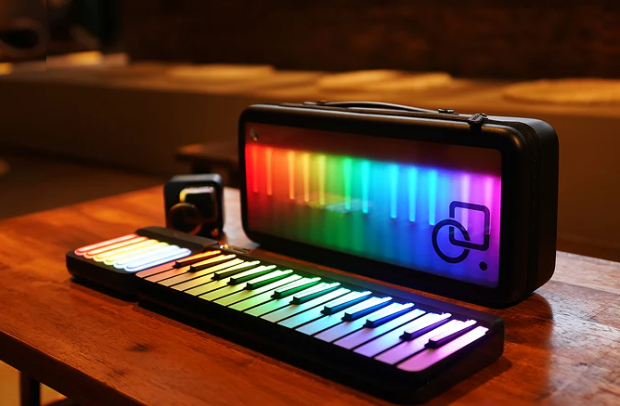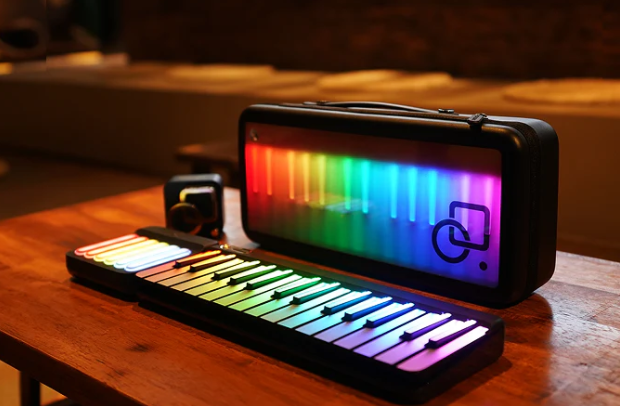
Music can feel like a secret language, but the idea of a key is one of its friendliest entry points. Crack this concept and suddenly chords, melodies, and even those mysterious key signatures begin to make sense. And that’s pretty neat.
At its core, a musical key is a home base—a set of notes that sound “right” together because they orbit the same tonal center (also called the tonic). When a song is “in C major,” for example, it means C feels like home, and the melody and harmony mostly pull from C major’s scale:
C – D – E – F – G – A – B – (…back to C)
Play “Happy Birthday” starting on C and ending on C, and you’ll hear that sense of arrival. That’s the key at work.
Knowing the key:
When people talk about types of keys, they usually start with major and minor. Major keys tend to feel bright or confident, while minor keys lean moody or introspective.
|
Key Type |
Scale Pattern (Whole = W, Half = H) |
Vibe |
|
Major |
W – W – H – W – W – W – H |
Upbeat, triumphant, sunny |
|
Minor |
W – H – W – W – H – W – W |
Mellow, somber, dramatic |
That said, plenty of sad songs are in major keys, and plenty of bangers are in minor. Music loves bending its own rules.
Look at a piece of sheet music and you’ll spot sharps (♯) or flats (♭) right after the clef. That cluster is the key signature—a cheat sheet telling you which notes are sharpened or flattened throughout the piece. Memorizing them isn’t as hard as it seems:
A little mnemonic magic—Father Charles Goes Down And Ends Battle (sharps) or its reverse (flats)—helps many players keep the order straight.
Every major key shares its signature with a relative minor. C major’s buddy is A minor; both have zero accidentals. They just start on different tonics. Knowing relatives doubles your usable key knowledge instantly. Pretty cool, right?
If you’ve heard guitarists rave about “Dorian” or church musicians drop “Mixolydian,” they’re talking modes—alternate ways of arranging the seven-note scale. Modes feel like cousins to major/minor keys:
While modes stretch beyond basic what is a key in music territory, they’re still built on the same principle: a tonal center plus a pattern of intervals.
Ear first, theory second—that’s the secret.
If the melody hovers around A and the chords keep circling back to A minor, congratulations—you’ve cracked it.
Ever notice how a pop ballad suddenly leaps up a whole step for a big final chorus? That’s modulation, and it exists to refresh your ears (and sometimes to amp up the drama).
Common modulation tricks:
Master these, and you’ll never fear changing keys mid‑song.
Keys shape mood, range, and even instrument resonance. Here’s how beginners can decide:
Digital smart instruments like PopuMusic Populele can auto‑light fret positions for any key. That means you can explore G♭ major’s dreamy vibe without sweating weird fingerings. Curious? PopuMusic interface is for a painless key‑hopping experience.
|
Term |
Plain‑English Meaning |
|
Tonic |
The “home” note of a key |
|
Dominant |
The fifth note in the key; wants to resolve to tonic |
|
Key Signature |
Sharps or flats shown at start of each staff line |
|
Scale Degree |
Position of a note within the scale (1st, 2nd, etc.) |
|
Relative Key |
Major/minor pair sharing the same key signature |
Once keys become second nature, you’ll:
Musical keys aren’t fences—they’re launchpads. They give structure so your creativity can soar without getting lost. Spend a week exploring each key, and pretty soon the Circle of Fifths will feel like a familiar neighborhood rather than a cryptic chart.
So grab your instrument, pick a key (start with friendly C or G), and let your ears guide the adventure. Before long, you’ll swap “What is key in music?” for “Which key suits my next song best?” That’s progress worth celebrating.
Pianists might grumble about C♯ major (seven sharps), but with practice—and maybe backlit frets on a PopuMusic smart uke every key becomes approachable.
A scale is the raw set of notes; a key is the context those notes create within a piece.
Sort of. It can switch keys (modulate) or flirt with borrowed chords, but at any given moment, your ears still sense one tonal center.
PopuMusic’s LED‑guided smart ukulele (Populele) can light the exact frets for scales and chords in any key, so you see the tonal center and I–IV–V progressions as you play. It turns “what are keys in music” into a hands‑on, no‑guesswork experience.
Ukulele: C, G, F, and A minor (simple shapes, minimal barre work). Guitar: G, C, D, A, and E (open‑chord friendly). Start there, then step into sharp/flat keys with guided practice on.
Pick a starting key (say C), play its scale and I–IV–V chords, then move to the next key (G) and repeat. With PopuMusic’s LED guidance, new notes and shapes are shown as you change keys—five focused minutes a day will cement all 12 keys. Try it with a smart uke from.
Yes. Transpose by moving each chord the same interval (or use a capo). Practice the new shapes with PopuMusic lessons; the smart fretboard can show fingerings in the new key so you can sing comfortably. Learn more on.
Read more

Difference Between Digital Piano and Keyboard: What to Know Before You Buy
Shopping for your first set of keys can feel like stepping into a candy store where everything looks delicious—but you only get one pick. Should you go for a fully‑fledged digital piano with all 88...

How High Should a Piano Keyboard Be? Ideal Height for Comfort & Technique
Finding the sweet spot for your keyboard or acoustic piano isn’t just about looking professional. The right height supports healthy posture, reduces fatigue, and lets your hands float across the ke...